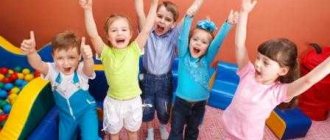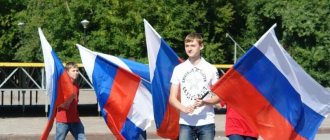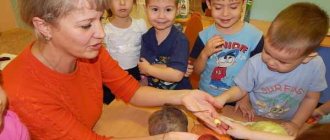“Forms, methods, technologies of working with preschool children in accordance with the Federal State Educational Standard for Education”
The world of childhood is unique and inimitable; childhood impressions, good and bad, remain in people’s memory forever. Scientists have long discovered that the decisive factor in the development of certain characteristics of thinking is not the experience itself (knowledge, abilities, skills), but the methods of its assimilation. Creative activity is a reliable assistant in raising and teaching children.
Our OOD is structured in such a way that one type of activity is replaced by another. This allows us to make the children’s work less tiring and intense. Game forms allow you to activate the cognitive interests of preschoolers, surprise, and ignite the flame of curiosity. In play activities, children intensively develop their powers of observation, memory, and imagination.
People have been using games as a learning method for a long time. Gaming activities can be used in the following cases: a) as independent technologies for mastering a topic or section; b) as elements of a broader technology; c) as a lesson or part of it (explanation, reinforcement).
Communication games involve working in pairs, groups of large and small, and as a whole group, while participants must be able to move freely around the room. For such games, a subject-spatial environment or child development centers are created, with rich mobile, replaceable material.
The pedagogical process should not impose a template approach to solving tasks; it should respect and develop the uniqueness of the individual style of each preschooler.
The educational games that I use in my classes are based on the principle of organizing classes in small groups. This makes it possible to include all children in active work, organize competition between teams, and develop the ability to work in a team. Game situations help create a positive attitude towards learning and development, which is a necessary prerequisite for successful learning of the material. Education is based on the following types of activities: cognitive, playful, creative, communicative. As a result, preschoolers will have sufficiently developed
moral standards of behavior, culture of communication in a team, ability to cooperate. When using games in my work, I take into account that they must have two principles: educational and cognitive and entertaining. Of the wide range of methods and techniques for working with children, those play activities that allow them to comprehensively solve developmental, educational and educational tasks are primarily used.
I also use the project method in my work. The essence of this method is to stimulate children’s interest in certain problems that require mastery of a body of knowledge, and through project activities to show the practical application of the acquired knowledge. If we talk about the project method as a pedagogical technology, then it involves a combination of research, search, and creative methods. Preschool age is fertile ground for the education, upbringing and development of a child - this period in the life of children is characterized by sustained attention, observation, and a surge of cognitive interest. That is why the most effective method in teaching children is the project method. This method develops interest in various areas of knowledge, develops skills in collective and independent work, activity, and helps connect learning with life. Project activities make it possible to unite a teacher - a senior friend and mentor, children, parents and other teachers - into one team.
Forms of organization of training in preschool educational institutions; educational and methodological material on the topic
Forms of organizing training in preschool educational institutions
The form of training organization is a way of organizing training, which is carried out in a certain order and mode.
The forms differ:
- according to the number of participants,
- the nature of the interaction between them,
- ways of activity,
- venue.
In kindergarten, frontal, group, and individual forms of organized education are used.
An individual form of educational organization allows you to individualize training (content, methods, means), but requires a lot of nervous effort from the child; creates emotional discomfort; uneconomical training; limiting cooperation with other children.
Group form of training organization (individual-collective). The group is divided
into subgroups. Reasons for completing: personal sympathy, common interests,
but not by levels of development. At the same time, it is first of all important for the teacher to ensure the interaction of children in the learning process.
Frontal form of training organization. Work with the whole group, clear schedule, uniform content. At the same time, the content of training in frontal classes can be activities of an artistic nature. The advantages of the form are clear
organizational structure, simple management, the possibility of interaction between children, cost-effectiveness of training; The disadvantage is the difficulty in individualizing training.
The main form of organization of education in a preschool educational institution is direct educational activities (DEA). Direct educational activities are organized and conducted by teachers in accordance with the main general education program of the preschool educational institution. ECDs are conducted with children of all age groups in kindergarten. In the daily routine of each group, the time for carrying out educational activities is determined in accordance with the “Sanitary and epidemiological requirements for the design, content and organization of the work schedule of preschool educational organizations.”
Direct educational activities are organized in all areas of educational work with children.
When conducting direct educational activities, there are three main parts.
The first part is introducing children to the topic of the lesson, defining goals, explaining what children should do.
The second part is the independent activity of children to complete the teacher’s assignment or the child’s own plans.
The third part is the analysis of the task completion and its evaluation.
Requirements for organizing direct educational activities
Hygienic requirements:
- Direct educational activities are carried out in a clean, ventilated, well-lit room;
- The teacher constantly monitors the correct posture of the child,
- Do not allow children to become overtired during classes.
- provide for the alternation of various types of children’s activities not only in different classes, but also during one lesson.
Didactic requirements:
- precise definition of educational tasks of GCD, its place in the overall system of educational activities;
- creative use of all didactic principles in unity when conducting educational activities;
- determine the optimal content of educational activities in accordance with the program and level of preparation of children;
- choose the most rational methods and techniques of teaching depending on the didactic purpose of the GCD;
- ensure the cognitive activity of children and the developmental nature of educational activities, rationally correlate verbal, visual and practical methods with the purpose of the lesson;
- use didactic games (printed board games, games with objects (plot-didactic and dramatization games)), verbal and gaming techniques, didactic material for learning purposes.
- systematically monitor the quality of acquisition of knowledge, skills and abilities.
Organizational requirements:
- have a well-thought-out plan for conducting GCD;
- clearly define the purpose and didactic objectives of GCD;
- competently select and rationally use various teaching aids, including TSE, ICT;
- maintain the necessary discipline and organization of children when
conducting GCD
- Do not mix the learning process with the game, because In play, the child masters to a greater extent methods of communication and masters human relationships.
- GCD in preschool educational institutions should not be carried out using school technologies;
- GCD should be carried out in a certain system, connecting them with the everyday life of children (the knowledge gained in the classroom is used in free activities);
- In organizing the learning process, integration of content is useful, which makes the learning process meaningful, interesting for children and contributes to the effectiveness of development. For this purpose, integrated and comprehensive classes are conducted.
Forms of organizing learning in everyday life.
Throughout the day, the teacher has the opportunity to carry out training using various forms of organizing children; frontal forms of training take place:
- walk, which consists of:
- observations of nature and surrounding life;
- outdoor games;
— labor in nature and on the site;
- independent play activities;
- excursions;
- games:
— plot-role-playing;
— didactic games;
- dramatization games;
- sport games;
- keeping children on duty in the cafeteria and in classes
- work:
- collective;
— household and household;
- work in a corner of nature;
- artistic work;
- entertainment, holidays;
- experimentation;
- project activities;
- reading fiction;
- conversations;
- puppet theater show;
- evenings-leisure;
In the preschool educational institution, special time is allocated during the implementation of regime moments, individual work with children is organized. The content of training in this case is the following types of activities:
- subject-game,
- labor,
- sports,
- productive,
- communication,
- role-playing and other games that can be a source and means of learning.
Methods and techniques for organizing training
In preschool educational institutions, visual and gaming methods in combination with verbal methods predominate. The learning process for children in kindergarten is based on visual
learning, and the special organization of the environment contributes to the expansion and deepening of children’s ideas.
Active methods and forms of teaching preschoolers
Svetlana Gnatyuk
Active methods and forms of teaching preschoolers
The goal of modern preschool education is the formation of personality through one’s own activities, the development of universal educational activities, cognitive activity , creativity of children and their personality through various types of activities.
One of the problems of today's education is the preparation of the future school student - a researcher who sees problems, has a creative approach to solving them, knows modern search methods , and knows how to obtain knowledge himself.
In this regard, modern pedagogy invites us to shift the emphasis from the passive model of learning (the child acts as an “object”
, simply listens and looks) into
active (the child acts as a “subject” of learning , i.e., works independently, performs creative tasks) and interactive (the child interacts with other participants in the educational process).
Active are the forms and methods in which educational (training)
The activity is creative in nature,
are formed .
The goal of active learning methods is to develop attention, speech, creativity, reflection, the ability to find optimal or simplest solutions, and predict results.
Thus, active learning methods are learning by doing .
Modern classes are considered as a constantly developing form and are built on the principles of cooperation, an activity-based approach and the use of active forms and methods of learning . It is on this basis that are formed : the ability to plan one’s activities, establish cause-and-effect relationships; navigate sources of information . The term "universal learning activities"
means the ability to learn, i.e. the child’s ability to self-develop through
active assimilation and acquisition of knowledge through practical activities .
Speaking about forms and methods of teaching , we mention activity as the ultimate goal and a necessary condition for development. activity is expressed in actions, in the ability to find ways to solve problems. To generate such activity, it is necessary to use productive methods .
The new educational situation requires the use of methods in the activity , independence and creativity of children in educational activities Active learning methods (AMT) in line with new approaches to organizing
.
Active teaching methods are a system of methods that ensure activity and diversity in the mental and practical activities of students in the process of mastering educational material. The essence of active teaching methods aimed at developing skills and abilities is to ensure that children complete those tasks, in the process of solving which they independently master skills and abilities. Active learning methods are one of the most effective means of involving children in educational and cognitive activities.
In general, active learning can be represented as follows:
1. Forced activation of thinking , when a child is forced to be active regardless of his desire.
2. A fairly long period of time for children to be involved in educational activities, since their activity should not be short-term or episodic, but largely stable and long-term.
3. Independent creative development of solutions, increasing the degree of motivation and emotionality of children.
4. Constant interaction between students and educators through direct and feedback connections.
All of the above corresponds perfectly to project activities
Active learning methods include the use of problem situations
When talking about active learning , we cannot ignore interactive forms . Interactivity means the ability to interact or be in a conversation mode, dialogue with something (for example, with a computer)
or anyone
(person)
.
The essence of interactive learning is that the educational process is organized in such a way that almost all children are involved in the process of cognition and have the opportunity to understand and reflect on what they know and think. Joint activity in the process of learning and mastering educational material means that everyone makes their own special individual contribution, knowledge, ideas, and methods of activity are exchanged. Moreover, this happens in an atmosphere of goodwill and mutual support, which allows not only to obtain new knowledge, but also develops the cognitive activity itself, transfers it to higher forms of cooperation and cooperation.
forms are also effective : all kinds of logic games, entertaining game exercises. We must not forget about role-playing games, which contribute to the development of imagination, creative thinking, initiative and independence of the child. Role play imitates reality by assigning roles to children and giving them the opportunity to act “as if for real.”
. The purpose of role-playing play is to determine children's attitude towards something and gain experience through play: it tries to help teach through experience and feelings. Sometimes children can act out their own situations that they have been in. It is also much easier to absorb and consolidate the material during the game.
Active learning is , of course, also search (cognitive and research)
activities: experiments, children's experimentation.
Children will never acquire so much new knowledge about the properties of, for example, a magnet, as during experimentation with it. It is also important to independently study the properties of objects , and both the senses and the hands should work.
You can conduct experiments frontally, work independently, or you can do them in pairs, when one is the subject and the other is the researcher. It is possible with children to solve experimental problems: “In how many ways can such and such an action be performed?”
,
"What happens if?"
,
“How to prove that?”
. And here you can also work individually, in subgroups, and as a competition between two teams.
Observations, for example, of earthworms, ants, birds, fish, etc., can also become active, when the teacher does not invest ready-made knowledge about the habits of these animals, but when children themselves observe, put forward hypotheses, establish cause-and-effect relationships, make conclusions.
Another active method is brainstorming.
– organization of collective mental activity to find unconventional ways to solve problems.
The purpose of a “brainstorming”
or
“brain attack”
is to collect as many ideas as possible from all children regarding a given topic over a limited period of time by disinhibition.
, methods of active learning that are completely new to us have appeared : “Cluster”
“Sinquain”
The purpose of conference classes: to promote children’s cooperation, to form cognitive activity , and the ability to transfer their knowledge to peers. The peculiarity of such game-activities is the preparation of a message and presentation by the child of the materials of his research.
For example, a pedagogical project was developed on the topic “Why can’t animals of hot countries live in our forests?”
.
Each child and their parents collected information and compiled research results about animals of their choice. Next came a joint synthesis of the research results and presentation . In the process of such communication are formed , i.e. the ability to exchange information and speech competence.
The use of interactive learning is carried out through the use of frontal and cooperative forms of organizing educational activities, interactive games and methods that promote learning the ability to discuss. The most used are:
— For the frontal form of work, the following technologies: microphone, “Brainstorming”
,
"Unfinished Sentence"
;
— In a cooperative form of work : work in pairs ( “Face to Face”
,
“One - together - all together”
, work in small groups, aquarium;
— Interactive games : “Role playing game”
,
"Dramatization"
.
During joint activities, an active method such as relaxation is used. The purpose of this method is to increase the energy level in the group and relieve unnecessary tension that arose during the lesson. As a rule, this can be physical education or an outdoor game.
Active learning methods also include
- use of various schemes and models, actions with substitute objects;
- the use of heuristic techniques - a teaching method through leading questions, promoting the development of resourcefulness and activity ;
— use of search questions;
- use of comparison techniques;
— guessing riddles;
— "revival of paintings"
and etc.
In order to develop in children the ability to independently put forward a problem and search for its solution, it is important to give a positive assessment to any, even incorrect, but independently found solution. It is necessary to celebrate even the very attempt to find a way to solve the problem, and then, with the help of leading questions from an adult, jointly find its correct solution.
Active , personally significant learning is a constant search , overcoming, some tension, effort on the part of the child, which, naturally, is associated with mistakes, miscalculations, and irrational ways of obtaining results. Therefore, during the learning should have the right to make mistakes, collective discussion of the put forward version, defend their opinion and support from an adult. When children make mistakes, the teacher should not overuse the expression “wrong”
,
“you don’t know”
,
“you’re not trying”
.
It is advisable to replace the categorical “wrong”
with the more democratic
“this is your opinion, you think so, let’s listen to the opinions of others
.
Although it is believed that active learning and constructing situations (problems)
in project activities is an innovation of the 21st century; in fact, the roots of this
technique go back to the distant past. Active learning methods develop in children not just knowledge-reproduction, but the skills and needs to apply this knowledge for analysis, evaluation and correct decision-making. The use of AMOs and their choice are determined by the goals and content of training , the individual characteristics of students and a number of other conditions.
With the help of active learning methods in preschoolers, you can develop , first of all, the important ability to carry out joint project and research activities, defend your position, justify your own opinion and be tolerant of others, as well as the useful skill of working in a team, and taking responsibility for others.
Types of forms of education for preschool children
The form of education, as part of the pedagogical process, depends on the goals, content and methods, while simultaneously determining their implementation in specific activities.
Finished works on a similar topic
Course work Forms of training and education of preschool children 430 ₽ Abstract Forms of training and education of preschool children 280 ₽ Examination Forms of training and education of preschool children 200 ₽
Receive completed work or specialist advice on your educational project Find out the cost
Based on this, the forms of education largely depend on specific pedagogical situations, and therefore they are very diverse, creative in nature and often individually unique.
Despite the uniqueness and individuality, it is customary to classify the forms of education of preschool children on a number of grounds.
Forms of education of preschool children depending on the number of participants in the process:
- Individual - carried out in the form of conversations, individual lessons of one student with a teacher, etc.
- Group – represent the educational work of a teacher with a group of students, within a circle, temporary group, etc.
- Mass - held in the form of holidays, rallies, processions, etc., in which several different age groups, the entire kindergarten or nearby preschool educational institutions take part.
Forms of education of preschool children depending on the main type of activity:
- forms of cognitive activity;
- forms of labor and socially useful activities;
- forms of aesthetic activity;
- physical culture and health-improving form of activity;
- value-oriented form of activity.
Forms of education depending on the method of educational influence on the child (author N. I. Boldyrev):
- Verbal forms - represent lines, conferences, meetings, gatherings, meetings, etc.
- Practical forms - represented by excursions, Olympiads, sports days, competitions, cleanup days, etc.
- Visual forms include visiting museums and exhibitions; creation of information stands on various topics, wall newspapers, etc.
Note 2
Thus, the forms of education of preschool children are divided depending on the method of educational influence, time and frequency, as well as on the number of participants.





